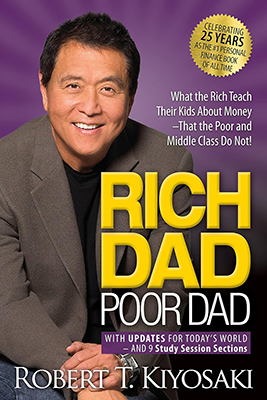Rich Dad Poor Dad
“Rich Dad Poor Dad” by Robert T. Kiyosaki is a personal finance classic that contrasts the financial teachings of the author’s “rich dad” (his friend’s father) with those of his “poor dad” (his own father). Here’s a summary:
- The Rich Dad, Poor Dad Contrast: Kiyosaki introduces readers to his two “dads.” His “poor dad” was his biological father, a highly educated man with a stable job but limited financial success. His “rich dad” was his friend’s father, an entrepreneur with less formal education but significant wealth.
- The Importance of Financial Education: Kiyosaki emphasizes the importance of financial education, which he believes is lacking in traditional schooling. He argues that understanding how money works and how to make it work for you is essential for achieving financial success.
- The Difference Between Assets and Liabilities: Kiyosaki introduces the concept of assets and liabilities. Assets are things that put money in your pocket, such as investments or rental properties, while liabilities are things that take money out of your pocket, such as mortgages or car payments. He advises focusing on acquiring assets and minimizing liabilities.
- The Cash Flow Quadrant: Kiyosaki introduces the Cash Flow Quadrant, which categorizes people into four groups based on how they earn income:
– E (Employee): Those who work for someone else.
– S (Self-Employed): Those who work for themselves, such as freelancers or small business owners.
– B (Business Owner): Those who own businesses that can operate without their direct involvement.
– I (Investor): Those who make money through investments rather than active work.
- The Importance of Passive Income: Kiyosaki advocates for building passive income streams, which generate money without requiring active work. This allows individuals to achieve financial independence and freedom.
- Investing in Assets: Kiyosaki encourages readers to invest in income-generating assets such as real estate, stocks, or businesses, rather than relying solely on earned income from a job.
- The Power of Mindset: Kiyosaki emphasizes the importance of mindset in achieving financial success. He encourages readers to adopt an entrepreneurial mindset, take calculated risks, and embrace opportunities for growth and learning.
- Financial Literacy for Children: Kiyosaki advocates for teaching financial literacy to children from a young age, to empower them with the knowledge and skills needed to achieve financial independence in adulthood.
Overall, “Rich Dad Poor Dad” offers valuable insights into personal finance and entrepreneurship, challenging conventional wisdom and providing practical advice for building wealth and achieving financial freedom.

